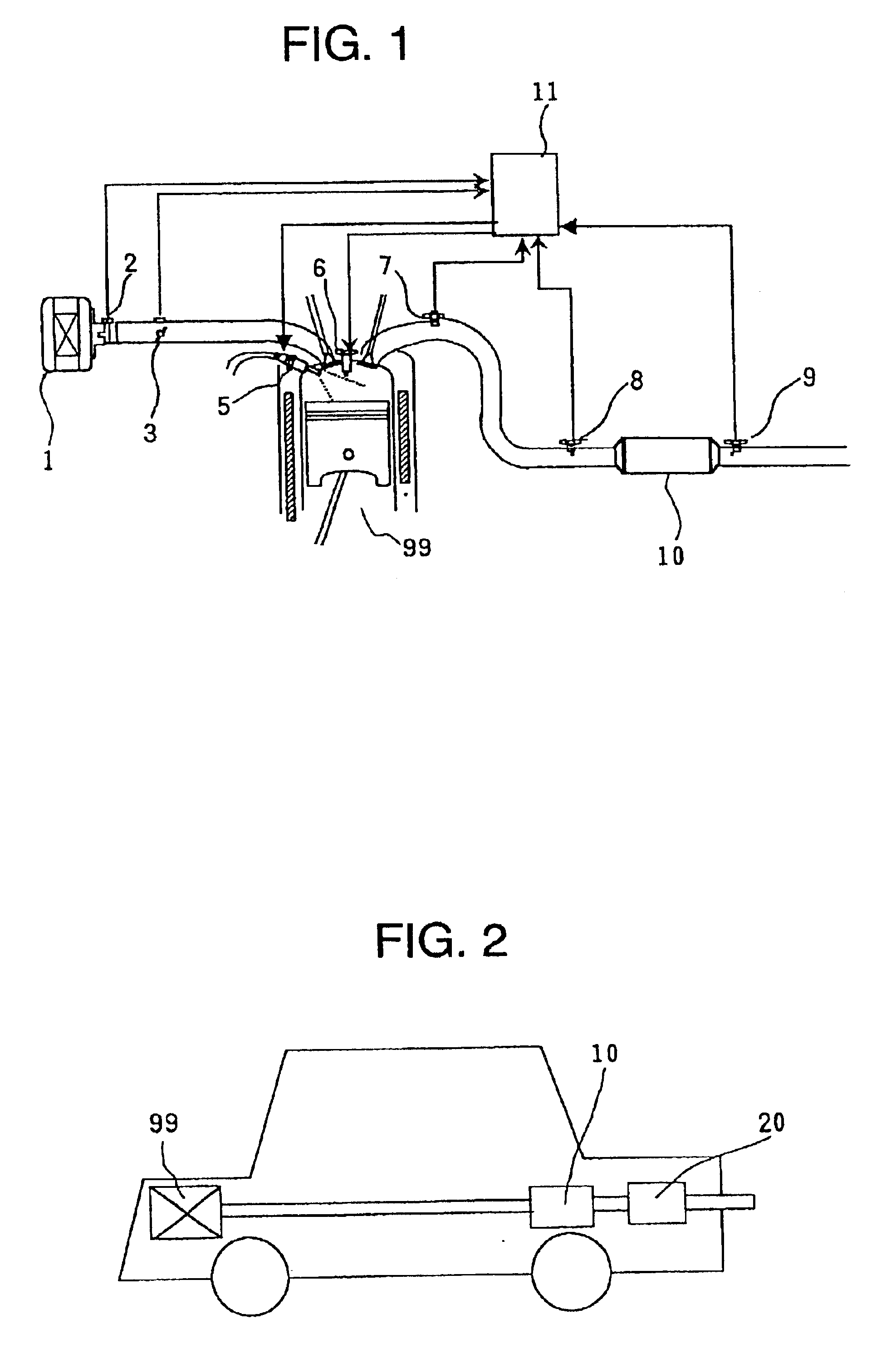Internal combustion engine exhaust gas purification apparatus, exhaust gas purification process and exhaust gas purification catalyst
a technology of exhaust gas purification and exhaust gas, which is applied in the direction of physical/chemical process catalysts, separation processes, arsenic compounds, etc., can solve the problems of undesired small specific surface area of the porous carrier itself, poor dispersibility of active components, etc., and achieve the effect of improving the heat resistance and sox resistance of the catalys
- Summary
- Abstract
- Description
- Claims
- Application Information
AI Technical Summary
Benefits of technology
Problems solved by technology
Method used
Image
Examples
example 1
A cordierite honeycomb (400 cells / inc2) was coated with a slurry prepared from alumina powder and alumina precursor and made acidic by nitric acid, dried and fired to obtain an alumina coat honeycomb as coated with 1.5 moles of alumina per 1 l of the apparent honeycomb volume. The alumina coat honeycomb was impregnated with a mixed solution of dinitrodiamine Pt nitric acid solution and Rh nitrate solution, dried at 200° C. and then fired at 600° C. Then, the supported Pt and Rh-contained honeycomb was impregnated with a mixed solution of Na nitrate solution, Mn nitrate solution and Pd nitrate solution, dried at 200° C. and then fired at 600° C. Thus, Example catalyst 1 containing 0.0022 parts by mole of Rh, 0.014 parts by mole of Pt, 0.8 parts by mole of Na, 0.2 parts by mole of Mn and 0.014 parts by mole of Pd in terms of metal elements on the basis of 1.5 parts by mole of alumina was prepared. The catalyst will be hereinafter expressed as 0.8 NaMnPd—RhPt / Al2O3. Likewise, Example C...
example 2
In the same manner as in Example 1, Example Catalysts 42 to 47 were prepared by adding Cu, Co or Ni to Example Catalysts 21 and 36, respectively, and evaluated according to Test Example 1. Amounts of supported Cu, Co and Ni were 0.1 part by mole each in terms of metal elements on the basis of 1.5 parts by mole of alumina.
Test Results
Test results are shown in Table 3. Example Catalysts containing Co, Ni or Cu had higher activities than those of Comparative Example Catalysts 1 to 14 shown in Table 1.
TABLE 3NOx eliminationefficiency (%)Catalyst300° C.400° C.500° C.Example Catalyst 42NaMgMnPd—RhPt0.1Cu / Al2O3939996Example Catalyst 43NaMgMnPd—RhPt0.1Co / Al2O3949995Example Catalyst 44NaMgMnPd—RhPt0.1Ni / Al2O3959997Example Catalyst 45LiNaKMnPd—RhPt0.1Cu / Al2O3879593Example Catalyst 46LiNaKMnPd—RhPt0.1Co / Al2O3869694Example Catalyst 47LiNaKMnPd—RhPt0.1Ni / Al2O3849993
example 3
In the same manner as in Example 1, Example Catalysts 48 to 51 were prepared by adding Ti or Si to Example Catalysts 21 and 36, respectively. Amounts of supported Ti and Si were 0.1 parts by mole each in terms of metal elements on the basis of 1.5 parts by mole of alumina.
PUM
| Property | Measurement | Unit |
|---|---|---|
| Fraction | aaaaa | aaaaa |
| Fraction | aaaaa | aaaaa |
| Volume | aaaaa | aaaaa |
Abstract
Description
Claims
Application Information
 Login to View More
Login to View More - R&D
- Intellectual Property
- Life Sciences
- Materials
- Tech Scout
- Unparalleled Data Quality
- Higher Quality Content
- 60% Fewer Hallucinations
Browse by: Latest US Patents, China's latest patents, Technical Efficacy Thesaurus, Application Domain, Technology Topic, Popular Technical Reports.
© 2025 PatSnap. All rights reserved.Legal|Privacy policy|Modern Slavery Act Transparency Statement|Sitemap|About US| Contact US: help@patsnap.com

